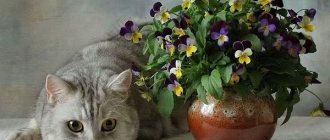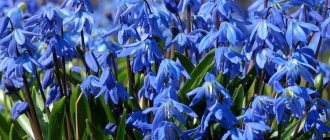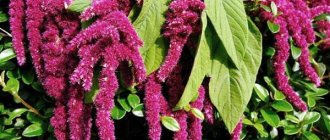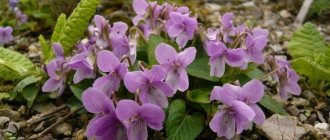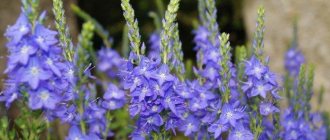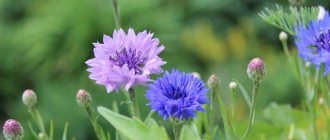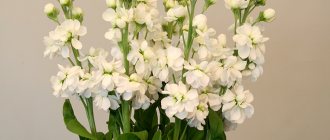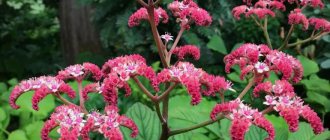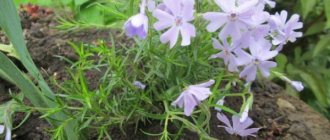The homeland of osteospermum is the Cape Valley (South Africa) and the Arabian Peninsula. This herbaceous perennial plant belongs to the Asteraceae family. Under natural conditions, the height reaches a meter; varieties bred for gardens are much lower (25-50 cm).
Author of the article
Maxim Sverchkov
Professional biologist and breeder with extensive experience and experience.
This plant is also called African (Cape, blue-eyed) chamomile (daisy). Petals of different colors, the core is blue, purple. It blooms from July until frost, and is grown in gardens and residential areas.
general information
Osteospermum is a very diverse genus, which includes completely herbaceous species and shrubs. They belong to the aster family, and came to us straight from the African continent. In colder climates, osteospermum is grown as an annual. And this is a wonderful decoration for your garden.
Osteospermum blooms at the height of summer and stops only in the second half of autumn. The average height is about 1 m, but it is impossible to say for sure here, because there are too many different varieties. The leaves of osteospermum are serrated, but unevenly, which is why they look doubly unusual.
The bright flowers are actually basket inflorescences. The diameter can vary from 4 to 11 cm, and the most common shades are white, pink, crimson, purple, yellow and orange. Another amazing feature is that the seeds are formed on the petals, and not in the middle.
Photo: avto.goodfon.ru
Short description
The osteospermum flower (Osteosopermum) is gaining popularity, which is not surprising, because it is a very ornamental plant, blooming beautifully and profusely in the first year of cultivation until frost. Osteospermum belongs to the Asteraceae family. It is cultivated mainly on balconies and terraces, although it is also planted in the garden. It is also called African, blue-eyed or Cape daisy, garden gerbera. Although African daisy has daisy-like flowers, it is by no means a classic daisy.
This is interesting. The name Osteospermum was given because of the very hard seeds of the plant. They are really very hard, like osteo, which means bone in Latin.
This undemanding flower will appeal to lovers of abundantly flowering plants. As the name suggests, the natural habitat of the African or South African chamomile is hot Africa. That's why it grows well on a south-facing balcony. Osteospermum loves full sun exposure; after sunset, the inflorescences curl inward, so you can observe the color of the outer petals.
This beautiful flower appeared in our country quite recently. However, its international spread began at the end of the last century. It is distinguished by a beautiful inflorescence, reaching a diameter of 6 and even 10 cm!
Biological characteristics:
- African daisies usually have a compact shape, sometimes looser, and can reach a height of 50 cm. There are dwarf varieties, so depending on the amount of available space, you can choose the right variety.
- leaves are lanceolate, with serrated edges.
- Inflorescences in the form of multi-colored baskets consisting of tubular and reed flowers. There are hybrids with reed flowers in the form of “teaspoons”. Plants bloom from spring to autumn - from May to October. Among the narrow leaves you can see numerous generative buds, announcing a long flowering period that lasts until autumn.
Types of osteospermum
There are about 50 types of osteospermum in nature, but not all of them are cultivated in the regions of Russia. Here are the varieties you should pay attention to!
Osteospermum Eklona
A very diverse category, which includes almost creeping bushes and tall spreading varieties up to 1.5 m. In most cases, white petals with pink veins radiate from the red or purple center.
Photo: moi-6-sotok.rf
Osteospermum pleasant
A very beautiful decorative variety with spectacular voluminous inflorescences of several rows of petals. Based on this species, garden hybrids have been bred that can change color.
Photo: oir.mobi
Shrub osteospermum
Creeping shoots quickly grow into a large flowering carpet. These are mainly white, lilac and red varieties, but the shape and size of the flowers may vary.
Photo: pixabay.com
Osteospermum noticeable
In its native Africa, it is a perennial that blooms almost all year round. Even here, its unusual pink petals delight us throughout the warm season.
Photo: oir.mobi
Osteospermum hybrid
An extensive category that includes all the most interesting developments by the breeder. They are often better adapted to different weather conditions and are also more decorative.
Photo: zen.yandex.ru
Marigolds (50 photos): types, care and planting in open ground
Description and features of osteospermum
Osteospermum is formed by a bush that grows up to 1 m in height, but it reaches such sizes extremely rarely and in flower beds samples of 0.5 m predominate. Usually the plant is grown by gardeners as an annual. The key feature is the aroma emitted by the foliage and stem, which have a slight pubescence over the entire surface.
Flowering begins in June and continues until the autumn cold, characterized by the abundant formation of new buds. In appearance, the flower resembles a chamomile, but with a larger palette of shades, such as light, scarlet and orange.
Dimensions vary from 2.5 to 7.5 cm; they can be seen open only in sunny weather, thus the annual protects its pollen. Osteospermum can slow down or even stop development during the summer heat, but you should not overwater the plant or start treating it. This reaction is natural and will go away on its own when the temperature returns to normal.
Osteospermum care
For an exotic African plant, osteospermum is quite unpretentious. It adapts well to our conditions and thrives with minimal care.
Temperature
Osteospermum tolerates heat well, so even the hottest Russian summer is quite comfortable for it. At the same time, it can withstand short cold spells at night and even light frosts, which allows it to bloom until severe cold weather.
Photo: tonshalovsky.ru
Lighting
Osteospermum needs bright sunlight, it’s not for nothing that it comes from Africa. It tolerates even direct sunlight well. But the shadow will not destroy the plant, but the flowering will be much poorer.
Photo: zen.yandex.ru
Watering
Osteospermum disgustingly tolerate high humidity, as a guest of their dry regions. The flowerbed does not need to be constantly watered. Careful and moderate watering will only be needed during prolonged drought.
Photo: wordyou.ru
The soil
Soil of any density is suitable, but breathable, loose soil is still preferable. Preferably slightly acidic or neutral, but we advise you to avoid alkaline ones.
Photo: oir.mobi
Fertilizers and fertilizing
For lush flowering, osteospermum needs regular feeding with complex fertilizers. It is advisable to apply them every 2-3 weeks, but in a small dosage - half the norm.
Photo: sadogorod25.ru
Wintering
In general, in our latitudes, osteospermum is an annual plant, and it dies with frost. But you can dig up the plant in the fall, without waiting for cold weather, and move it into a pot in a cool room. This way it will continue to bloom.
Photo: sbermegamarket.ru
Eschscholzia (60 photos): types, planting and care in open ground
Osteospermum flower: growing from seeds at home
The development of the plant does not depend on the length of the day, so it can be grown equally well in spring and autumn. African chamomile is usually sown in late February - early March.
Throughout our country, osteospermum is grown by sowing seeds for seedlings. To do this, choose loose, permeable soil with a slightly acidic or almost neutral reaction (pH from 5.8 to 6.2). The best choice is universal flower soil, which must be fresh.
Low containers, pots, trays are filled with earth. The seeds are scattered over a well-moistened surface and sprinkled with a low layer of soil (1-1.5 cm). It is best to use vermiculite to sprinkle the seeds, which retains moisture around the seeds for a long time. After sowing, the containers are covered with film or glass to maintain high soil and air humidity at 95-97 percent.
Cape daisy seeds do not require light to germinate, but they do not need to be kept in the dark either. A little lighting during this period can improve germination. Seeds germinate at temperatures from 18 to 20 degrees Celsius within 5-6 days, and roots form on 8-12 days. During this period, be sure to water the soil with Fitosporin to prevent the appearance of various fungal diseases or rot.
After most of the seeds have germinated, the shelter is removed, placed in a well-lit place and the temperature at night is reduced to 16-17 degrees. As soon as the seedlings grow a little, they can be fed with a weak solution of nitrogen fertilizer with a small amount of phosphorus. Powerful lighting helps strengthen the root system and accelerates the growth of shoots.
When one or two pairs of true leaves appear on the plants, pick osteospermum. To do this, choose plastic cups with a diameter of 3 to 5 cm and universal flower soil with a pH of 5.8-6.2. The picking is carried out very carefully, trying to preserve everything, even the most delicate roots.
Osteospermum seeds
A week after transplantation, the plants are again fed with a weak solution of nitrogen fertilizers. When growing, it is worth remembering that African chamomile grows and develops best in cool temperatures and powerful lighting. Also, much attention is paid to irrigation, with the help of which the soil is maintained in a sufficiently moist state. Watering is carried out in the morning so that by night the leaves of the plant are completely dry. Drying out and overflowing of the earthen coma lead to the rapid death of the bushes.
As soon as the roots of the plants have entwined the ball, they are again transferred to pots with a diameter of 10 cm, preserving the earthen ball. After this transplant, the night growing temperature begins to be gradually reduced to 10-13 degrees, and the daytime temperature should remain at 16-21 degrees.
Flowers appear on the bushes when 4 to 6 pairs of true leaves are fully formed. The quality and quantity of flowers is directly affected by high light levels and cool night temperatures.
All the time, cultivation from sowing to the beginning of flowering takes from 12 to 16 weeks, provided that agricultural technology is carried out in full. If the temperature and other growing factors cannot be maintained, the growing time will increase. Ready seedlings are planted outside after the end of frost (May - June).
When grown indoors or in greenhouses, pests such as aphids and thrips may appear on plants. To destroy aphids, they are treated with Actellik, Tanrek or Biotlin, the solution of which is prepared according to the instructions.
To combat thrips, choose “Fitoverm”, “Agravertin”, “Vertimek” or other means, but first of all, diseased plants must be separated from healthy ones, since this dangerous pest moves from one plant to another at high speed.
Planting and propagation
Osteospermum is propagated by seeds, and even a beginner can handle it. Plant in regular containers with peat closer to mid-spring, carefully deepen with a toothpick and leave in a warm place at 20 degrees. Within a week, shoots will appear, and you can move the container closer to the sun.
Unlike many flowering plants, it is best not to soak osteospermum seeds before planting. It is enough to leave them in a damp cloth for a couple of hours. Seedlings can be pruned as needed when at least 2-3 adult leaves appear on them.
If you have tall varieties, we advise you to pinch the top a little so that the plant grows faster and then blooms more luxuriantly. Gradually harden the seedlings on the balcony, and by the end of spring transplant them into open ground at a distance of 20-25 cm from each other.
Photo: attuale.ru
Agrotechnics of cultivation.
All varieties of Osteospermum are grown following a general algorithm. The plant loves sunny places and loose soil. In shaded areas, Osteospermum is not very decorative and blooms poorly. He doesn't like drafts either.
When preparing the soil, sand, humus, and leaf soil are added in equal quantities. Osteospermum responds well to the application of complex mineral fertilizers. They can be added to the soil during planting, as well as during the growing season 2-3 times. In this case, the flowering period lengthens, and the buds become large and rich. If the soil is properly fertilized, flowering will last all summer.
Important! For better tillering of the plant, the top buds of the stem should be pinched. The bush becomes not only decorative and fluffy, but also becomes resistant to wind currents.
And for more abundant flowering, you should remove the fading buds without allowing the seeds to ripen (if seeds are required, then you need to leave the first few inflorescences, marking them). Otherwise, the plant will spend a lot of energy on ripening seeds due to a decrease in the quality of flowering.
Pest and disease control
Osteospermum is fantastically resistant to pests and infections. The main problems arise only if the plant is regularly flooded. Then the roots begin to rot, and the flower itself suffers from fungus. Severely damaged osteospermum will most likely have to be destroyed. In the early stages, simply reduce watering, remove all diseased areas and use fungicides.
Photo: imageban.ru
Flower Hazel grouse (50 photos): types, planting and care in open ground
Use in landscape design
Traditionally, African chamomile is grown in flower beds; it helps create bright accents in the foregrounds of shrub borders, in rock gardens, and is indispensable in decorative tubs and flowerpots in patios and terraces.
For amateur flower growers, the versatility of the plant is most attractive - osteospermum is equally good both on terraces and in classic flower beds, balconies or verandas. In empty areas, semi-dwarf or compact species are used as ground cover. The osteospermum mix is perfect for decorative framing of ridges, for central flower beds, for decorating a container garden, and it simply looks great in groups in mixborders. The flowering bush is unpretentious and very hardy , therefore it is suitable for places with poor soil, rocky hills, and slopes.
Osteospermum – photo
With all the simplicity of the inflorescences and colors, the carpet of these African daisies looks simply luxurious. Just look!
Photo: agbina.ru
Photo: datchnik.ru
Photo: tezarvape.ru
Photo: most-beauty.ru
Photo: dic.academic.ru
Photo: mykaleidoscope.ru
Photo: wallbox.ru
Photo: pixabay.com
Photo: na-dache.pro
Photo: mykaleidoscope.ru
Photo: distano.ru Photo: 2sotki.ru
Photo: flo.discus-club.ru
Photo: mykaleidoscope.ru
Photo: agbina.ru
Photo: pxhere.com
Photo: sadtem.ru
Photo: ravaka.ru
Photo: grandgames.net
Photo: happymodern.ru
Photo: semstomm.ru
Photo: ravaka.ru
Photo: jooinn.com Photo: 2sotki.ru
Photo: prorastet.ru
Did you like the post? Subscribe to our channel in Yandex.Zen, it really helps us in our development!
What do osteospermum seeds look like?
Osteospermum is an ornamental evergreen plant with erect, occasionally creeping stems. It has serrated leaves and bears basket-like inflorescences. The marginal flowers of the crop, depending on the variety, can be purple, violet, white, yellow or orange. The central part is usually dark.
Osteospermum seeds in the photo look like oblong, ribbed brown grains. One of their tips is rounded and thickened, the other is pointed and tapering.
Favorable period for landing
At the time of disembarkation you should have a strong shoot. Seedlings should be transferred to the ground in late spring - early summer, when the weather is consistently warm.
Seedlings should be planted in an area that is well heated by the sun. The main thing is that there are no sharp winds here. The soil for the plant must be fertile, loose, and fertilized.
The process of planting in the ground is best done on a sunny and warm day. The seedlings need to be dug out of the container along with the soil and placed in a prepared hole. Compact the soil and then water it with water. A large distance must be maintained between plants. It should be approximately 50-100 cm.
